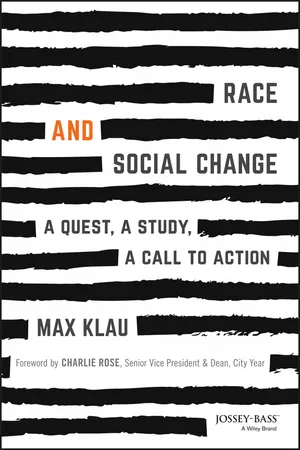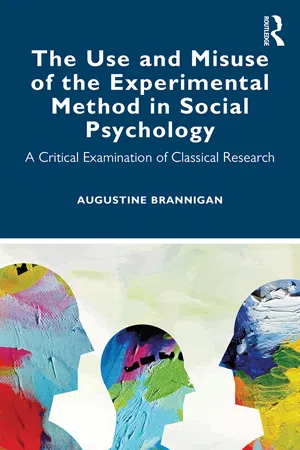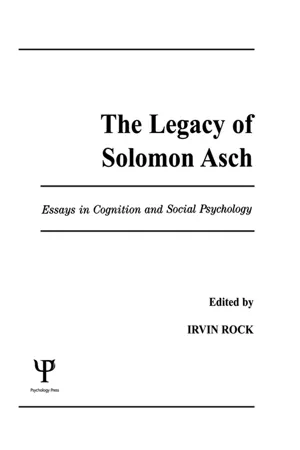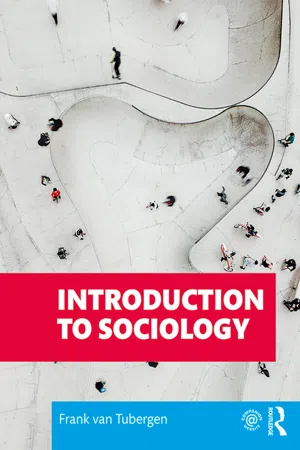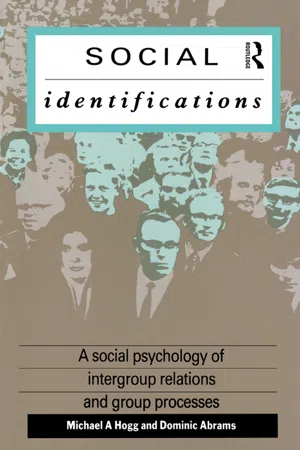Psychology
Asch Conformity Experiments
The Asch Conformity Experiments were a series of studies conducted by psychologist Solomon Asch in the 1950s. The experiments demonstrated the power of social influence and conformity, showing that individuals often yield to group pressure, even when they know the group is wrong. The findings have had a significant impact on our understanding of social behavior and group dynamics.
Written by Perlego with AI-assistance
Related key terms
9 Key excerpts on "Asch Conformity Experiments"
- eBook - ePub
Race and Social Change
A Quest, A Study, A Call to Action
- Max Klau(Author)
- 2017(Publication Date)
- Jossey-Bass(Publisher)
Still, the Milgram experiment endures as an infamous and iconic undertaking in the history of the social sciences. To this day, it challenges us to think deeply about our own tendencies to obey authorities even when confronted with demands that fly in the face of our own moral code and ethical standards.Solomon Asch's Conformity Experiments
In the early 1950s, social psychologist Solomon Asch (1951) set out to explore the dynamics of conformity. Similar to Milgram, he felt compelled to understand the powerful ways that ordinary individuals are influenced by their interpersonal relationships—in this case, with peers:Our immediate object was to study the social and personal conditions that induce individuals to resist or yield to group pressures when the latter are perceived to be contrary to fact. The issues which this problem raises are of obvious consequence for society; it can be of decisive importance whether or not a group will, under certain conditions, submit to existing pressures. (p. 177)In his experiment, Asch gathered a group of eight individuals and asked them to take a simple perceptual test. In this case, the task was to view flashcards presenting a series of lines; participants were asked to identify which of the last three lines of various lengths perfectly matched the length of the first line on each flashcard. The subject of the experiment was unaware, however, that all seven of the other individuals involved were actually collaborators who were part of the experiment. On multiple occasions, the seven individuals unanimously asserted that a line that was clearly too long or too short was the line that matched the length of the first line. The subject was then placed in the position of having to either deviate from the group by saying what he or she perceived to be the correct answer or make the choice to ignore the evidence of his or her own senses in order to conform to the group. In his original experiment, Asch found that more than 30% of participants chose to conform to the group, suggesting that roughly one out of every three people would make statements that they did not believe to be true rather than risk standing alone in their responses. - eBook - ePub
Psychoanalysis, Classic Social Psychology and Moral Living
Let the Conversation Begin
- Paul Marcus(Author)
- 2019(Publication Date)
- Routledge(Publisher)
Seder (a ritual service and ceremonial dinner for the first night in Israel or first two nights of Passover in the diaspora). He saw his grandmother pour an extra glass of wine in a ceremonial cup and asked whom it was for. “For the prophet Elijah” (who heralds the messiah), an uncle told him. “Will he really take a sip?” the little boy asked. “Oh, yes—you just watch when the time comes,” the uncle replied. Excited with the sense of suggestion and expectation, Asch was convinced that he “saw the level of wine in the cup drop just a bit.” It was this experience that sensitized him to the power of social pressure and conformity (Stout, 1996, n.p.).Asch thus orchestrated an elegantly simple experiment to explore the extent to which social pressure from a majority group could influence a person to conform.1 In social psychology, conformity is defined as “the convergence of individual’s thoughts, feelings, or behavior toward a group norm” (Smith et al., 2015, p. 315). The original study, along with select follow-up studies, are summarized herein.Asch used fifty male students from Swarthmore College to participate in a “‘psychological experiment’ in visual judgment” (Asch, 1955, p. 32). Using a line judgment task, Asch situated a naïve subject (the “real” participant) in a room with seven confederates, whom had consented, prior to the line task presentation, to what their responses would be. The naïve subject was not aware of this and was made to believe that the seven confederates were real participants like they were. Each person in the room had to articulate aloud which comparison line on the large white cards (A, B or C) was most similar to the standard line. The correct answer was always entirely obvious. The naïve subject sat at the end of the row of chairs and provided his or her answer last. There were 18 trials altogether, and the confederates gave the incorrect answer on 12 trials (i.e., the “critical trials”). Asch wanted to discern if the naïve subject would conform to the view of the majority. He also had a control condition that excluded any naïve subjects, only real participants. The results were astonishing. About one-third of the naïve subjects acquiesced and conformed to the obviously incorrect majority on the critical trials. Moreover, during the critical trials, about three-quarters of naïve subjects conformed on at least one occasion and one-quarter never conformed. In the control group, less than 1% of the naïve subjects gave the incorrect answer (Asch, 1951; McLeod, 2008). - eBook - ePub
- Kevin Wren(Author)
- 2013(Publication Date)
- Routledge(Publisher)
Normative influences, on the other hand, occur because as humans we have a need for social acceptance and approval. We often go along with the group because we dislike disapproval, we want to achieve a specific goal and being accepted is thought to be necessary to achieve it or we simply just enjoy cultivating approval in others. The following study is an example of this.Solomon Asch and normative social influences
Study
Another psychologist called Solomon Asch (1951, 1952, 1956) conducted a series of experiments that were much more tightly controlled than those of Sherif. (See article 2 in the key research summaries in chapter 6 . Read this now.) His procedure became the standard for most replications by others investigating variables in conformity such as gender and culture, as we shall see later.Evaluation
The summaries of Asch’s results are misleading though. A closer examination of all of Asch’s results shows that despite an overall yield to group pressure, i.e. normative influence, there are many individual differences. Some participants did not conform, conformity was not consistent in all participants, and the range of responses was wide.These variations are important since they point to the possibility that Asch may have been testing a number of aspects of conformity or a much more complex situation than was first thought, as we will discuss below.Asch’s interviews with his participants after the experiments showed that many of them were clearly anxious. This stemmed partly from their desire to be in harmony with the rest of the group (the confederates of Asch), which meant they had to deny the evidence of their own eyes. They also thought it could be damaging to be a dissenter. Asch reports that many of the non-yielders ‘longed’ to agree with the majority. One of Asch’s strongest non-yielders remarked: ‘It is more pleasant if one is in agreement.’ Another described his feelings as: ‘I felt disturbed, puzzled, separated like an outcast from the rest. Every time I disagreed I was beginning to wonder if I wasn’t beginning to look funny.’ Like Milgram, this aspect has ethical implications. Was Asch ‘right’ to misinform his participants and subject them to such feelings?In Asch’s experiments normative influences were at work. The participants were responding to the demands of social identity - eBook - ePub
The Use and Misuse of the Experimental Method in Social Psychology
A Critical Examination of Classical Research
- Augustine Brannigan(Author)
- 2020(Publication Date)
- Routledge(Publisher)
Perry’s account raises important questions about this type of research. First of all, there was no informed consent for participants. The boys’ parents and the church leaders used to recruit the subjects were told that the camps were recruiting participants to study leadership and character, to explore new methods of camping and other cover stories. But neither the parents, the boys nor those who helped recruit them were ever de-briefed after the experiments were over. When Perry contacted former participants decades later, they were dismayed to have been “used” in this fashion, and many had very mixed memories about their summer camp experiences. In addition, the camps exposed the participants to trauma that would have been less prevalent if the counsellors had acted less as impartial observers, and more as responsible adults. The experimenters also purposely engaged in activities in all three camps that were designed to offend the participants (sabotaging the boys’ tents and fouling their clothing and other possessions) in order to provoke aggressive retaliation, and to nudge the boys to provide evidence that embellished Sherif’s expectations. Unlike the autokinetic effect, this was a high impact dramatization based on deception by psychologists who did not seem overly preoccupied with the welfare of the young persons entrusted to their care for weeks at a time. The evidence suggests that the summer camps were used to illustrate Sherif’s theories. Not to test them.Asch and the resistance to social pressure
The work of Solomon Asch is the second classical contribution to social influence research in American psychology in this period. It appeared just after the Second World War. Where Sherif stressed how subjects were influenced by the group outlook, Asch was interested in the grounds of resistance to group pressure. He developed his ideas over the course of several publications (1951, 1952, 1955, 1956) that examined social pressure on individuals working in groups. He never referred to Sherif’s field experiments. Where Sherif had studied social influence where the stimulus was inherently ambiguous and where individuals seemed to drift unconsciously into a consensus by exchanging opinions, Asch pointed to the social and individual conditions that compelled individuals to accept or reject opinions that they perceived to be contrary to fact. Sherif appeared to attribute the subject’s knowledge to “the operation of suggestion and prestige” (Asch 1951:178). Asch stressed the predicament of the individual who can see differently from others but who experiences pressures to mimic them, and whose individual freedom is jeopardized as a result by a majority rule.What was the existential problem for Asch?
As with Sherif, it is not clear what concrete issue initially motivated Asch’s experimentation. On the one side, he appears to be making an intellectual response to Sherif. To be sure, he appears to have been involved in H. G. Sperling’s MA thesis that replicated Sherif’s work (in large part), and he devotes a significant portion of space in Social Psychology to a critical engagement with Sherif. Sperling’s unpublished thesis was titled, “An Experimental Study of Some Psychological Factors in Judgment,” and was presented at the New School for Social Research in 1946. It was reviewed by Asch at length (1952:487–90, 501) to challenge the validity of Sherif’s paradigm. On the other hand, in all his publications, he stresses the context of propaganda and the manipulation of public opinion in the mass media. He proposes a basic study of interpersonal behaviors in order “to make fundamental advances in the understanding of the formation and reorganization of attitudes, of the functioning of public opinion, and of the operation of propaganda” (1951:177). He worries that the technical extensions of mass communications have created “the deliberate manipulation of opinion and the ‘engineering of consent’” (1955:31). The final chapter of Social Psychology - eBook - ePub
The Legacy of Solomon Asch
Essays in Cognition and Social Psychology
- Irvin Rock, Irvin Rock - DECEASED(Authors)
- 2014(Publication Date)
- Psychology Press(Publisher)
There is an irony worth noting here. Contemporary text books cite the “Asch experiments” (Asch, 1951, 1955) as perhaps the ultimate demonstration of the individual’s dangerous and mindless conformity to the whims and views of the majority. Asch’s own view, of course, was quite different. Conformity to group standards, he insisted, generally would reflect a rational and adaptive response, one that depended heavily upon the capacity of group consensus to influence the object of the individual’s judgment as much as the judgment of that object. Thus, Asch (1940) explained in reporting an earlier and somewhat less celebrated conformity study, when one subject learns that his peers have derogated the profession of “politician,” and another learns that the same profession has been rated more highly than virtually any other, the two subjects’ own evaluations actually pertain to two very different types of politicians. In the first case, the assessment deals with corrupt ward bosses and political hacks (an interpretation of the object of judgment that is both consistent with the peers’ derogation and likely to prompt and justify similar derogation by the subject); in the second case the assessment deals with statesmen and effective national leaders like Jefferson or Roosevelt (this time, an interpretation consistent with, and demanding of, high regard by subject and peers alike). Conformity in the classic Asch situation thus constituted an exceptional, even unique, “special case” in which reinterpretation or altered construal of the stimulus, and of the group’s response to that stimulus, is all but impossible (see Moscovici, 1985 ; Ross, Bierbrauer, & Hoffman, 1976). 1 1 A followup study by Allen and Wilder (1980) has since offered direct support for Asch’s construal interpretation - eBook - ePub
- Frank van Tubergen(Author)
- 2020(Publication Date)
- Routledge(Publisher)
why they conformed to the majority group and gave wrong estimates (Asch, 1956, 1961). Roughly speaking, the participants gave two kinds of answers. One group of subjects answered that they thought they must have misperceived the length of the line in some way, and hence followed the group opinion. Therefore they believed the group was right and their own judgment was wrong. The other group of subjects, however, believed they had it right personally, hence they did not agree with the group. Nevertheless, they conformed to the group judgment—so they adjusted their behavior—because they feared social disapproval when they stated their own opinions publicly.In a follow-up study to the work of Asch, Deutsch and Gerard argued that these two kinds of responses by the subjects of the Asch experiment reflect two mechanisms which can explain positive social influence (Deutsch & Gerard, 1955). First, there is what they call informational social influence , which they defined as “influence to accept information obtained from another as evidence about reality”. Second, there is normative social influence , which is “influence to conform to the positive expectations of another”. This kind of influence is based on the desire to receive social approval from peers, and to avoid social sanctions and punishment from the group when not conforming to the social norms. Thus, in the Asch experiment, subjects who believed they were right and others were wrong might have decided to conform to the beliefs of others and thereby avoid possible negative sanctions of the others in the classroom. In this case, beliefs about reality—factual statements—are normative, i.e., statements in the form of “X is true” are not neutral but normative and not agreeing with them can have social consequences. Sociologists have developed the social control theory around this idea and applied it to numerous social phenomena. In Chapter 6 - eBook - ePub
- Richard Gross, Rob McIlveen(Authors)
- 2016(Publication Date)
- Routledge(Publisher)
Participants in the control group conditions made correct judgements 95 per cent of the time. In contrast, in the presence of unanimous, incorrect judgements, 80 per cent of participants agreed at least once with the incorrect majority. Some 8 per cent of the participants agreed with the incorrect majority all of the time, and on average participants conformed between four and five times on the critical 12 trials. Asch interviewed each participant after the experiment: those who agreed with the majority most of the time gave various reasons for their behaviour. For example, that the group was actually correct, that they did not want to spoil the experimenter’s results, and that they went along with the majority to avoid creating disharmony and conflict. Participants who did not conform gave the following reasons for maintaining independence: confident their judgement was correct, and thinking the majority was correct but could not agree with them since that was not what they saw.The Asch experiments are frequently misrepresented as demonstrating high levels of conformity. Friend, Rafferty and Bramel (1990) draw attention to the fact that in the original study, almost two-thirds of the naïve participants resisted group pressure to conform (Asch, 1951). In spite of this, a review of nearly 100 American Social Psychology texts published between 1953–85, showed that the emphasis was, and continues to be, consistently on the experimental participants who made 37 per cent errors over the 12 critical trials. The critique by Friend et al. (1990) also alerts us to the dilemma as to whether 37 per cent of conforming responses constitutes a high or low level of conformity. Asch had intended to demonstrate independence and was himself surprised by the results. As the correct answer was so obvious, he expected that naïve participants would not be swayed by majority influence (Campbell, 1990).The Asch paradigm is costly in terms of time and the number of confederates needed, and requires good acting from the confederates. Crutchfield (1955) devised an alternative experimental model: he had five participants sit in separate booths, side by side. In front of each participant was a box with lights and switches on it, as shown in Figure 8.4 - eBook - ePub
- Kenneth S. Bordens, Irwin A. Horowitz(Authors)
- 2013(Publication Date)
- Psychology Press(Publisher)
As we know, Frank ultimately decided to disobey the judge’s authority. He changed his vote to not guilty. However, consistent with what we now know about social influence, he was not convinced. His behavior change was brought about primarily through normative social influence. This is reflected in the sentiment he expressed just before he changed his vote: He changed his vote so as not to hold up the jury but he would “never feel right about it.”Chapter Review- What is conformity?
Conformity is one type of social influence. It occurs when we modify our behavior in response to real or imagined pressure from others. Frank, the man cast into the role of juror in a criminal trial, entered the jury deliberations convinced that the defendant was guilty. Throughout the deliberations, Frank maintained his view based on the information he had heard during the trial. However, in the end, Frank changed his verdict. He did this because of the perceived pressure from the other 11 jurors, not because he was convinced by the evidence that the defendant was innocent. Frank’s dilemma, pitting his own internal beliefs against the beliefs of others, is a common occurrence in our lives. We often find ourselves in situations where we must modify our behavior based on what others do or say.
- What is the source of the pressures that lead to conformity?
The pressure can arise from two sources. We may modify our behavior because we are convinced by information provided by others, which is informational social influence . Or we may modify our behavior because we perceive that a norm , an unwritten social rule, must be followed. This is normative social influence . In the latter case, information provided by others defines the norm we then follow. Norms play a central role in our social lives. The classic research by Sherif making use of the autokinetic effect showed how a norm forms.
- What research evidence is there for conformity?
Solomon Asch conducted a series of now-classic experiments that showed conformity effects with a relatively clear, simple perceptual line judgment task. He found that participants conformed to an incorrect majority on 33% of the critical trials where a majority (composed of confederates) made obviously incorrect judgments. In postexperimental interviews, Asch found that there were a variety of reasons why a person would conform (yield) or not conform (remain independent).
- eBook - ePub
Social Identifications
A Social Psychology of Intergroup Relations and Group Processes
- Dominic Abrams, Michael A. Hogg(Authors)
- 2006(Publication Date)
- Routledge(Publisher)
No theoretical link is made between conformity and normative behaviour or group belongingness. And yet norms, as prescriptive consensuses, are heavily implicated in conformity: factors which enhance conformity (e.g. the unanimity of the majority, the criteriality of the behaviour to the group’s existence, that the group need only contain sufficient members for a clear consensus to be perceived) all contribute to the normative clarity of the group’s behaviour, and to the prescriptive relevance of the behaviour to the individual. The anaysis of conformity as adherence to norms, or as normative behaviour, cannot simply be conjured out of a collection of separate interpersonal processes. Recently, however, norms have once again been brought centre-stage, initially by Moscovici and Faucheux, who reinterpret the Asch paradigm as an exercise in minority influence rather than conformity of an individual to a majority (Moscovici and Faucheux 1972). They remind us that no experiment occurs in a social vacuum divorced from the effect of the subjects’ extra-experimental real-life experiences (Tajfel 1972c). The subjects in the Asch paradigm are not faced by an erroneous majority but rather by an erroneous minority which makes judgements of line length that are starkly at variance with the judgements people reliably make in the real world. The experimental group norm is at odds with the real-world norm brought to the experiment by the subjects, and the explanation of conformity must rest upon an examination of why some subjects choose the experimental group norm to determine their behaviour rather than the real-world norm. Moscovici and Faucheux have essentially stood the Asch paradigm on its head and reminded us, in Cooley’s words, that ‘the one who seems to be out of step with the procession is really keeping time to another music’ (Cooley 1902:301)
Learn about this page
Index pages curate the most relevant extracts from our library of academic textbooks. They’ve been created using an in-house natural language model (NLM), each adding context and meaning to key research topics.
